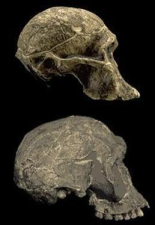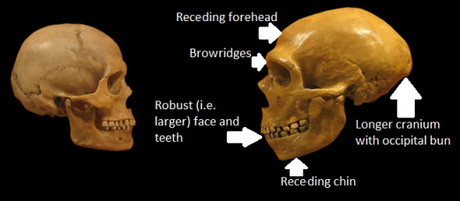As the new Dmanisi finds show, species can be difficult to spot and define in the fossil record. To circumvent this problem some palaeoanthropologists divide the human family into “grades” of broadly similar species. Here is part 2 (link to part 1) of my quick and dirty guides to the skulls of those grades, so you can figure out which members of the family you have round to Christmas dinner (answer: if its anything but grade 6 please contact your friendly neighbourhood palaeoanthropologist).
Grade 4 – transitional forms

Top is a grade 3 species. Bottom is a grade 4 species, showing how it has a slightly bigger brain and flatter face
For over 4 million years the brains of our ancestors remained the same. The, about 2.3 million years ago we begin to see an increase in size. This key feature marks the emergence of our genus, Homo and the start of grade 4. These species are generally called “transitional” because although they do have bigger brains, they’re still far from modern humans. Their brains are only typically 50 – 75% bigger than grade 3 hominins whereas ours are more than double that size.
Aside from the brain they’re also starting to differ from grade 3 species in appearence. They’re face is becoming less prominent and flatter. But, like the brain, its still far from your average member of Homo. If you have some of the rest of the skeleton, this theme of “starting to differ but not quite fully human” is present in the rest of the body. Their arms are slightly shorter than grade 3 species, but still not as stubby as ours are, for example.
Basically its big brained grade 3 species that’s starting to look human, but not human enough to join the cool hominins club.
Grade 5
Grade 5 covers most of our genus Homo, from around 2 million years ago to a mere 195,000 years ago. Its a huge portion of prehistory, during which time evolution continued. Brains continued to get bigger, faces became flatter and generally smaller (what we call “gracile”). Teeth also began to decrease in size, which some take as a sign they were beginning to prepare their food before eating it, perhaps with fire.
By the end of this period they’d started to resemble us in all the key ways. Their brains were just as big as ours (if not bigger) and their faces were almost as flat. Yet there even then there were still a few key characteristics that are used to distinguish between grade 5 (or archaic) species and modern humans.
These include:
- A lack of forehead. The cranium of grade 5 species just slopes back. receding
- No prominent chin. Aside from a weird exception, their jaw slopes back like their foreheads
- Prominent browridges. I always find it weird that on Star Trek browridges are used to identify aliens when just 30,000 years ago they would’ve been a key feature that separates us from another species of human
- Generally more robust. Although they were becoming gracile (particularly when compared to earlier grades) these species were still more strongly built than us.
- Their cranium remains differently shaped. In particular the back of their skull has a rounded “occipital bun”
And in case that was all a bit too difficult for you to picture in your head, I made a pretty picture for your eyes!

Grade 6 – Humans
Do I really need to elaborate? We’re the big brained species with flat, upright foreheads. And the only members of our family still alive

